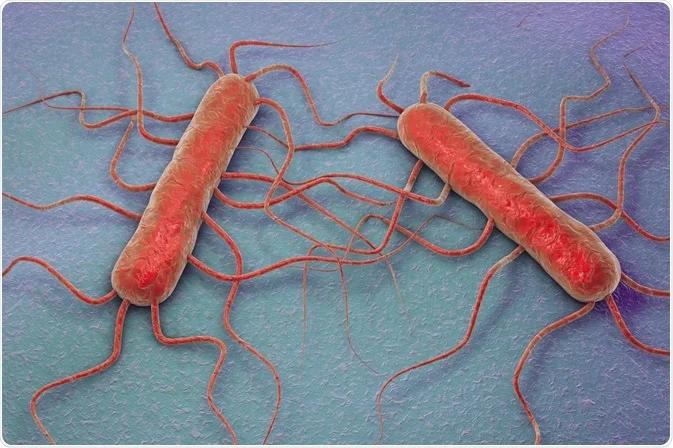Listeria monocytogenes is a gram-positive and facultative intracellular bacterium that has a predilection for causing central nervous systemic infections and listeriosis.

Listeria monocytogenes is a gram-positive, psychrotolerant, and facultative intracellular bacterium that has a predilection for causing central nervous systemic infections and listeriosis, a foodborne illness in humans and domesticated animals.
This pathogen can be found worldwide in the food supply, and most L. monocytogenes infections are acquired through the ingestion of contaminated food. The main clinical syndromes caused by L. monocytogenes include febrile gastro-enteritis, perinatal infection, and systemic infections marked by central nervous system infections with or without bacteremia.
L. monocytogenes infection can result in non-invasive gastrointestinal listeriosis or invasive listeriosis. In Invasive listeriosis can cause abortion in pregnant women and meningitis in immunocompromised individuals.
A significant outbreak occurred in South Africa in 2017–2018, with a high fatality rate. Infants, pregnant women, and individuals with certain conditions are at higher risk. L. monocytogenes can also cause urinary tract infections.
Listeria monocytogenes has been extensively studied as a model pathogen, largely from the perspective of innate and adaptive immune responses to intracellular infection and bacterial entry and survival within mammalian cells. There is also a growing body of data concerning CNS infections caused by L. monocytogenes.
Listeria monocytogenes is an uncommon human pathogen. It is mostly identified through cases of invasive disease, either associated with outbreaks or as sporadic infections, and through food safety programs.
Nonperinatal cases of invasive listeriosis have an estimated worldwide incidence ranging from 0.1–1.1 cases per 105 people. CNS infections are present, on average, in 47% of infected patients, with an average case-fatality rate of 36%.
Transmission:
- Monocytogenes are transmitted in humans through contaminated food.
- Processed meats and undercooked meats
- Unpasteurized dairy products
- It can also be found in irrigation waters and agricultural soils, posing a risk to fresh produce.
- Poor implementation of SSOP
- Transmission through transplacentally
- Rupturing of the amniotic membrane
- During vaginal delivery,
Virulence Factor:
- Adaptive acid tolerance response
- Internalin’s A and B are bacterial membrane proteins that allow for host cell membrane proteins that allow for host cell adherence (E-Cadherins and Met on host cell).
- Listerlysin and phosphatidylinositol-specific phospholipase C are used to escape from the host cell vacuole.
- Actin polymerization for intracellular motility (tumbling motility)
Signs and symptoms:
- Fever
- Headache
- Loss of balance
- Confusion
- Muscle aches
- Confusion
Environmental Persistence:
Cold shock proteins:
Cold shock proteins (CSPs) enable replication, transcription, translation, and protein folding at low temperatures. Glycine, betaine, and carnitine are imported as cryoprotectants to protect against cold stress.
Increased intracellular solutes help reduce the loss of intracellular water at low temperatures. A mutant strain lacking glycine betaine and carnitine uptake systems cannot survive at low temperatures. Membrane structure in L. monocytogenes changes at low temperatures, increasing rigidity.
In oxidative stress:
Oxidative stress can occur during food processing due to exposure to ROS. L. monocytogenes has ROS detoxification systems like catalase, superoxide dismutase, and alkyl hydroperoxides. The ferritin-like protein protects L. monocytogenes from the oxidative effects of hydrogen peroxide.
In osmotic stress,
- Monocytogenes can withstand high salt concentrations (NaCl).
- It activates primary and secondary responses to osmotic stress.
- Potassium cations and glutamate enter the cell during the primary response. Osmo protectants like
- Glycine, betaine, and carnitine are taken up.
- Two genes (lmo1078 and lmo2085) are responsible for cell envelope modification.
In low ph:
- Monocytogenes use the Acid Tolerance Response (ATR), Arginine Deiminase (ADI), and Glutamate Decarboxylase (GAD) systems for persistence in low pH environments. The ATR system is activated by pre-exposure to sublethal pH (5–6) and helps endure highly acidic settings.
- These mechanisms also protect against osmotic stress and high temperatures.
- ADI system: Arginine deiminase hydrolyzes arginine to citrulline and ammonia.
- Ornithine carbamoyl transferase converts citrulline to ammonia and carbamoyl phosphate. Carbamate kinase synthesises ATP using carbamoyl phosphate and ADP.
- The F0F1-ATPase-ATPasex is a mechanism for acid tolerance.
- It has two domains: F1 for ATP synthesis and hydrolysis and F0 as a proton channel. The enzyme synthesises ATP aerobically or hydrolyzes ATP to generate a proton motive force.
Antimicrobial resistance:
- Monocytogenes have adapted to environmental stresses and developed antimicrobial resistance. The development of novel antimicrobial agents is important in combating this pathogen.
Examples:
- Transfer of plasmid IP501 to L. monocytogenes via conjugation
- Transfer of AMR pAM beta 1
Biofilm formation:
- Monocytogenes form persistent cells and biofilms to withstand antibiotics and harsh conditions. They can withstand disinfectants, host defence systems, high temperatures, pressure, and preservatives.
- Biofilms are populations of bacterial cells enclosed in a matrix of extracellular polymeric substances. The matrix acts as a protective barrier against heat, desiccation, heavy metals, and antimicrobial agents.
- Persistent L. monocytogenes strains have better biofilm-forming capabilities. Biofilms contribute to increased tolerance to certain compounds and can protect against biocides.
Diagnosis:
First, we take blood and CSF samples and culture them on blood agar, and after growth, we make their slides and see them under a microscope.
Result:
- Gram positive coccibacilli
- Narrow zone of B-hemolysis
Preventions:
- Cooked food properly.
- Do not eat undercooked food.
- Use ready-to-eat foods.
- Wash your hands properly.
- Keep the refrigerator clean.
Treatment:
Penicillin, gentamycin, and cotrimoxazole are used for the treatment of Listeria monocytogenes.
This article is jointly authored by Muhammad Hamza, Aziz Ur Rehman, Faisal Rehman, Usman Ali, and Zil-e-Huma from the University of Veterinary and Animal Sciences Lahore, Subcampus Jhang.